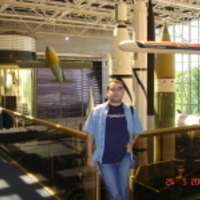Papers by Annye Tessaro

A utilizacao dos tablets como instrumento pedagogico e uma realidade que esta aos poucos surgindo... more A utilizacao dos tablets como instrumento pedagogico e uma realidade que esta aos poucos surgindo no contexto escolar. Os dispositivos moveis ja fazem parte da rotina dos estudantes. Na era digital, estar conectado e fazer parte do mundo, e ter uma posicao privilegiada da informacao e da comunicacao. Considerar esses dispositivos como instrumentos pedagogicos emerge da necessidade de se agregar a realidade dos estudantes ao contexto educacional. A insercao dos tablets ja esta ocorrendo, ainda que de forma incipiente e em um contexto amplo, sem muitas pesquisas que comprovem sua eficacia, verificam qual o melhor modelo e como os estudantes se comportarao frente aos tablets como instrumento didatico. Recursos, aplicativos e ate mesmo livros digitais precisam ser discutidos e avaliados sob uma otica planejada, bem fundamentada em teorias de aprendizagem, de semiotica e de design para que seu potencial possa ser explorado e o seu objetivo cumprido. Os livros digitais interativos, elabor...

A humanidade sempre se utilizou de narrativas para se comunicar. Ao longo dos anos, os teoricos p... more A humanidade sempre se utilizou de narrativas para se comunicar. Ao longo dos anos, os teoricos perceberam haver nas narrativas uma estrutura e uma formulacao basica comum que propiciava que as historias se perpetuassem e se adaptassem formando novas historias. As contribuicoes de Aristoteles, Vladimir Propp e Jung, fundamentadas com base na observacao de um corpus variado de contos e de fabulas, possibilitaram ao estudioso Joseph Campbell elaborar uma estrutura narrativa denominada “Jornada do Heroi”, um ciclo eliptico e evolutivo no qual o eixo central e o heroi (e tambem suas variacoes, tal como o anti-heroi). Essa estrutura e amplamente utilizada na construcao de narrativas contemporâneas e abriu o caminho para que roteiristas como Vogler e Mckee propusessem sua adaptacao centrada no protagonista-heroi para a literatura e o cinema, Com a evolucao das possibilidades interativas, a industria de entretenimento passou a incorporar, a partir da decada de 1970, ainda que modestamente,...
Iii Coloquio Luso Brasileiro De Educacao a Distância E Elearning, Sep 1, 2013
RENOTE, Jan 1, 2010
Este estudo tem como objetivo construir o mapa conceitual da produção do livro-texto do Programa ... more Este estudo tem como objetivo construir o mapa conceitual da produção do livro-texto do Programa Nacional de Formação em Administração Pública - PNAP e identificar a equipe envolvida no processo. O estudo é caracterizado como exploratório, descritivo, estudo de caso, com ...
Thesis Chapters by Annye Tessaro

Tese, 2018
A humanidade sempre se utilizou de narrativas para se comunicar. Ao longo dos anos, os teóricos ... more A humanidade sempre se utilizou de narrativas para se comunicar. Ao longo dos anos, os teóricos perceberam haver nas narrativas uma estrutura e uma formulação básica comum que propiciava que as histórias se perpetuassem e se adaptassem formando novas histórias. As contribuições de Aristóteles, Vladimir Propp e Jung, fundamentadas com base na observação de um corpus variado de contos e de fábulas, possibilitaram ao estudioso Joseph Campbell elaborar uma estrutura narrativa denominada “Jornada do Herói”, um ciclo elíptico e evolutivo no qual o eixo central é o herói (e também suas variações, tal como o anti-herói). Essa estrutura é amplamente utilizada na construção de narrativas contemporâneas e abriu o caminho para que roteiristas como Vogler e Mckee propusessem sua adaptação centrada no protagonista-herói para a literatura e o cinema, Com a evolução das possibilidades interativas, a indústria de entretenimento passou a incorporar, a partir da década de 1970, ainda que modestamente, a narrativa como possibilidade de refinar a imersão nos games utilizando, na maioria das vezes, a Jornada do Escritor (estrutura adaptada por Vogler) como parâmetro para construção das narrativas em games. No entanto, é essencial que se perceba que os games possuem particularidades específicas, além de um alto teor de interação diferenciando-se das outras mídias e, portanto, sua estrutura não pode ser concebida da mesma forma como foi proposto por Vogler, requerendo uma adaptação que contemple tais particularidades. Além disso, geralmente os profissionais que se dedicam à arte narrativa para games ou são roteiristas (que não parece ser o mais adequado, pois a arte narrativa vai além do roteiro), ou são escritores (que em sua maioria não possuem conhecimento e qualificações específicas na área de games). Diante do exposto, defende-se a adoção de Designer de Narrativas (termo criado, em 2006, pelo Game Designer Stephen Dinehart) para designar esse profissional cujo conhecimento envolve múltiplas habilidades – como programação, arte e escrita – combinando as áreas da narratologia, da ludologia e do Game Design. Sendo assim, a proposta desta tese é investigar as estruturas narrativas convencionais e como elas se apresentam nos games, quais são os elementos e as ferramentas que podem auxiliar o designer de narrativas no processo criativo.
Humanity has always used narratives to communicate. Over the years, theorists have realized that there was a common basic structure and formulation in the narratives that allowed stories to perpetuate and adapt in order to form new stories. The contributions of Aristotle, Vladimir Propp and Jung, based on the observation of a varied corpus of tales and fables, enabled the scholar Joseph Campbell to elaborate a narrative structure called “Hero’s Journey”, an elliptical and evolutionary cycle in which the central axis is the hero (and also its variations, such as the anti-hero). This structure is widely used in the construction of contemporary narratives which paved the way for writers such as Vogler and Mckee allowing them to propose it’s adaptation centered on the protagonist-hero for literature and cinema. From the 1970s, with the evolution towards an interactive possibility, the entertainment industry began to incorporate, although modestly, the narrative as a possibility to improve the immersion in games using, most of the time, the Writer’s Journey (structure adapted by Vogler) as a parameter for the construction of narratives in games. However, it is essential to realize that games have specific peculiarities, besides a high content of interaction differing from other media and, therefore, its structure can not be conceived in the same way as it was proposed by Vogler, requiring an adaptation which addresses such particularities. In addition, usually professionals who engage in storytelling for games are screenwriters (which does not seem to be the most appropriate because the art of narrative goes beyond the script), or are writers (who mostly lack specific knowledge and qualification in the games area). Considering what was stated above, we argue for the adoption of a Narrative Designer (term created in 2006 by Game Designer Stephen Dinehart) to designate this professional whose knowledge involves multiple skills – such as programming, art and writing – combining the areas of Narratology, Ludology, and Game Design. Thus, the purpose of this thesis is to investigate conventional narrative structures and how they are presented in games, which are the elements and tools that can help the narrative designer in the creative process.











Uploads
Papers by Annye Tessaro
Thesis Chapters by Annye Tessaro
Humanity has always used narratives to communicate. Over the years, theorists have realized that there was a common basic structure and formulation in the narratives that allowed stories to perpetuate and adapt in order to form new stories. The contributions of Aristotle, Vladimir Propp and Jung, based on the observation of a varied corpus of tales and fables, enabled the scholar Joseph Campbell to elaborate a narrative structure called “Hero’s Journey”, an elliptical and evolutionary cycle in which the central axis is the hero (and also its variations, such as the anti-hero). This structure is widely used in the construction of contemporary narratives which paved the way for writers such as Vogler and Mckee allowing them to propose it’s adaptation centered on the protagonist-hero for literature and cinema. From the 1970s, with the evolution towards an interactive possibility, the entertainment industry began to incorporate, although modestly, the narrative as a possibility to improve the immersion in games using, most of the time, the Writer’s Journey (structure adapted by Vogler) as a parameter for the construction of narratives in games. However, it is essential to realize that games have specific peculiarities, besides a high content of interaction differing from other media and, therefore, its structure can not be conceived in the same way as it was proposed by Vogler, requiring an adaptation which addresses such particularities. In addition, usually professionals who engage in storytelling for games are screenwriters (which does not seem to be the most appropriate because the art of narrative goes beyond the script), or are writers (who mostly lack specific knowledge and qualification in the games area). Considering what was stated above, we argue for the adoption of a Narrative Designer (term created in 2006 by Game Designer Stephen Dinehart) to designate this professional whose knowledge involves multiple skills – such as programming, art and writing – combining the areas of Narratology, Ludology, and Game Design. Thus, the purpose of this thesis is to investigate conventional narrative structures and how they are presented in games, which are the elements and tools that can help the narrative designer in the creative process.
Humanity has always used narratives to communicate. Over the years, theorists have realized that there was a common basic structure and formulation in the narratives that allowed stories to perpetuate and adapt in order to form new stories. The contributions of Aristotle, Vladimir Propp and Jung, based on the observation of a varied corpus of tales and fables, enabled the scholar Joseph Campbell to elaborate a narrative structure called “Hero’s Journey”, an elliptical and evolutionary cycle in which the central axis is the hero (and also its variations, such as the anti-hero). This structure is widely used in the construction of contemporary narratives which paved the way for writers such as Vogler and Mckee allowing them to propose it’s adaptation centered on the protagonist-hero for literature and cinema. From the 1970s, with the evolution towards an interactive possibility, the entertainment industry began to incorporate, although modestly, the narrative as a possibility to improve the immersion in games using, most of the time, the Writer’s Journey (structure adapted by Vogler) as a parameter for the construction of narratives in games. However, it is essential to realize that games have specific peculiarities, besides a high content of interaction differing from other media and, therefore, its structure can not be conceived in the same way as it was proposed by Vogler, requiring an adaptation which addresses such particularities. In addition, usually professionals who engage in storytelling for games are screenwriters (which does not seem to be the most appropriate because the art of narrative goes beyond the script), or are writers (who mostly lack specific knowledge and qualification in the games area). Considering what was stated above, we argue for the adoption of a Narrative Designer (term created in 2006 by Game Designer Stephen Dinehart) to designate this professional whose knowledge involves multiple skills – such as programming, art and writing – combining the areas of Narratology, Ludology, and Game Design. Thus, the purpose of this thesis is to investigate conventional narrative structures and how they are presented in games, which are the elements and tools that can help the narrative designer in the creative process.